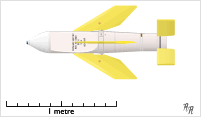SeaCat missile
| Seacat | |
|---|---|

Seacat GWS-20 series missile
|
|
| Type | Surface-to-air missile |
| Place of origin | United Kingdom |
| Service history | |
| In service | 1962 |
| Used by | See operators |
| Wars |
1971 Indo-Pakistani War Iran-Iraq War Falklands War South African Border War |
| Production history | |
| Designer | Short Brothers |
| Manufacturer | Short Brothers |
| Variants | See variants |
| Specifications | |
| Weight | 68 kg |
| Length | 1.48 m |
| Diameter | 0.22 m |
| Warhead | 40 lb (18 kg) continuous-rod warhead |
|
Detonation
mechanism |
Proximity |
|
|
|
| Engine | 2 stage motor |
| Wingspan | 0.70 m |
|
Operational
range |
500–5,000+ m |
| Speed | Mach 0.8 |
|
Guidance
system |
CLOS and radio link |
|
Steering
system |
Control surfaces |
|
Launch
platform |
Ship |
Seacat was a British short-range surface-to-air missile system intended to replace the ubiquitous Bofors 40 mm gun aboard warships of all sizes. It was the world's first operational shipboard point-defence missile system and was designed so that the Bofors guns could be replaced with minimum modification to the recipient vessel and (originally) using existing fire-control systems. A mobile land-based version of the system was known as Tigercat.
Seacat was designed by Short Brothers of Belfast for use against first and second generation 1950s, jet aircraft of Sea Hawk speed, that were proving to be too difficult for the WWII-era Bofors guns to successfully intercept. The missile was based on the Shorts Green Light prototype, itself a development of the SX-A5, a research missile based on the Australian Malkara anti-tank missile to test radio manual guidance of a short-range surface-to-air missile. It replaced the Orange Nell development programme for a lighter weapon than the enormous Sea Slug missile. The first public reference to the name Seacat was April 1958, when Shorts was awarded a contract to develop a close-in short-range surface-to-air missile. Royal Navy acceptance of Seacat as a point defence system instead of the Bofors L60 and the more effective Bofors L70 with proximity fused shells was controversial as many doubted the effectiveness of Seacat.
As well as use, in point defence against air attack, Seacat was justified as an anti missile and decoy against Styx missiles of the Warsaw Pact navies and Middle East and Asian clients of the Soviet Union. And as a 'large shell' for junk bashing and countering fast attack craft. It was sold as a easy and affordable introductory missile. and modern looking, with seeming effectiveness from 1/2 quad launchers, it offered savings manning, maintenance and space and weight compared with the Mk 5 Twin Bofors and STAAG type mountings, which limitations were more obvious. Above all its sold British export, warships and appeared a example of UK technological progress in line with the Sandys 1957 defence review and new broom. The missile was shown for the first time to the general public at the 1959 Farnborough Air Show. The first acceptance trials of the Seacat on a warship was in 1961 aboard HMS Decoy. The Seacat became the first operational guided missile to be fired by a warship of the Royal Navy. Later it was adopted by the Swedish Navy, making it the first British guided missile to be fired by a foreign navy.
...
Wikipedia
